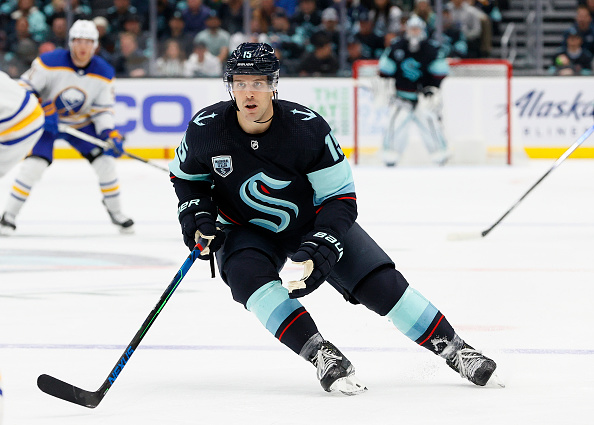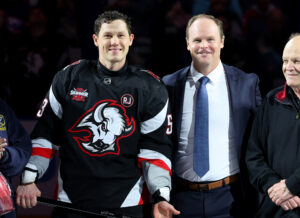NHL player development seems to always result in more questions than answers. How likely is it for a top pick to pan out? What makes a player a “steal”? Last Word On Hockey will be starting a new series on how to properly develop prospects from all different spots throughout the draft. This week’s piece involves draft picks in the back-half of the first round and how they were used early in their careers.
NHL Player Development Of First-Round Picks
In the span of 2005 through 2015, there were 84 total selections made between 16th overall and 30th overall on forwards playing in North America. Looking at all 84 forwards, they were split into different categories. Those categories were “Forwards Deemed NHL-Ready and Brought In Immediately When Ready,” “Forwards Near NHL-Ready and Brought In Immediately When Near-Ready,” “Forwards Rushed Slightly,” “Forwards Rushed,” “Forwards Forced,” “A Little Patience,” “Patience,” and “Too Much Patience.”
There were 16 forwards who fell into the fourth category, “forced,” on the list. Of those 16 players, three made their NHL impacts in their DY+4 seasons or later. Those players are Riley Sheahan, Frederik Gauthier, and Kenndal McArdle. In this piece, let’s look at Sheahan.
In this piece, we will be using stats from eliteprospects (raw stats) and hockey-reference (ice time). Additionally, the analytics we are using are as follows: even-strength offence goals above replacement (EVO), even-strength defence goals above replacement (EVD), wins above replacement (WAR) and goals above replacement (GAR). Those analytics are from evolving-hockey (subscription required).
NHL Player Development Of Riley Sheahan
Sheahan, drafted 21st overall by the Detroit Red Wings in the 2010 NHL draft, came out of the NCAA with the University of Notre Dame. Before joining Notre Dame, however, he played with St. Catherines Falcons in the GOJHL in his DY-1 season. There, he scored 27 goals and 46 assists for 73 points in 40 games, for 1.825 points per game. That ranked 10th out of the 84 aforementioned forwards in DY-1 production. Joining the NCAA, as a true freshman, Sheahan scored six goals and 11 assists for 17 points in 37 games, for 0.46 points per game. That ranked 82nd out of those same 84 forwards in DY production. After being drafted, Sheahan would play two more NCAA seasons and one AHL season before getting a true shot at the NHL.
In his DY+1 season, his second with Notre Dame, he scored five goals and 17 assists for 22 points in 40 games, for 0.55 points per game. That ranked 73rd out of the 82 forwards still outside of the NHL in DY+1 production. In his final NCAA season, Sheahan scored nine goals and 16 assists for 25 points in 37 games, for 0.676 points per game. That ranked 53rd out of the 70 forwards still outside the NHL in DY+2 production. Joining the AHL, Sheahan put up 16 goals and 20 assists for 36 points in 72 games, for 0.5 points per game. That ranked 26th out of the 46 forwards still outside the NHL in DY+3 production.
How Riley Sheahan Was Used
In his first true taste of the NHL, Sheahan split the year between the AHL and NHL. At the AHL level, he scored eight goals and 10 assists for 18 points in 31 games. That allowed him to get a long look at the NHL level. Playing in 42 NHL games, he averaged 14:27 time on ice per game. In that role he scored nine goals and 15 assists for 24 points. A very solid production line, his analytics reflected that strong rookie season further. His EVO (5.9) and EVD (-1.2) were both good for a rookie, although his EVD is a bit low. However, it was, alongside his strong EVO, enough to carry his WAR (1.3) and GAR (6.9) to strong scores.
After a solid rookie year, Sheahan would see a full season up at the NHL level. Playing 79 games, he averaged 15:39 per game. In a slightly better role than the year prior, he scored 13 goals and 23 assists for 36 points. A solid out-put again, Sheahan would be a more well-rounded player. His EVO (3.1) dropped quite a bit, but his EVD (1.9) was miles better. With the improved defensive score, his WAR (1.6) and GAR (8.5) both got slightly better.
Maintained Role Leads To Drop In NHL Player Development
In his third NHL season, Sheahan would again play the full year up with the big club. Across 81 games, he averaged a very similar role, at 15:14 per game. With a very similar role, he scored 14 goals and 11 assists for 25 points. That was a big step back in offensive production, and that step back was evident when looking at his analytics. His EVO (-0.1) and EVD (-1.0) both fell below replacement level. WIth his even-strength impacts falling pretty low, his WAR (-0.2) and GAR (-1.2) both followed suit, anchored down.
After that third season, in 2015-16, Sheahan would play just one more season and a small part of a second season with the Red Wings. In that time, he played a final 88 games with Detroit, scoring just 13 points. Getting moved to the Pittsburgh Penguins, he would play the rest of the 2017-18 season and half of the 2018-19 season with them. In that span, which included 122 games, he scored 18 goals and 23 assists for 41 points. Getting dealt by Pittsburgh, he would join the Florida Panthers. He would only finish the 2018-19 season with Florida, scoring 10 points in the final 33 games.
Riley Sheahan Bounces Around
In 2019-20, he would join the Edmonton Oilers, where he played one season with, scoring 15 points. The next season, 2020-21, Sheahan joined the Buffalo Sabres, scoring 13 points in 53 games. Again, he would join a new team the following year (2021-22), this time becoming a member of the Seattle Kraken. There, he scored 17 points in 69 games, and he would also see some AHL time (two points in four games). In 2022-23, Sheahan would once again be on a new team. He is currently with the Sabres organization, but has yet to play a single game in his second tenure with the team.
Sheahan Was Not The Right Choice
Hindsight is 20/20, but Riley Sheahan was not the right choice back in the 2010 draft for Detroit. While he was playing at a higher level than most with Notre Dame, there were several NCAA commits that were playing at a lower level at the time who turned out better. Some of those players are Kevin Hayes, Charlie Coyle, and Brock Nelson.
Nelson ended up out-producing Sheahan in his second NCAA season while Sheahan was in his third. Coyle out-produced Sheahan in his first season while Sheahan was in his second. Then Coyle left to tear apart the QMJHL. Hayes had very similar production as Sheahan in the NCAA, but he heavily out-produced Sheahan in their pre-NCAA seasons in weak leagues. Detroit went with the guy who, at the time, was playing better competition and was doing moderately well, as opposed to going with guys who had higher potential, joining the NCAA the year after the draft.
Junior league stats via Elite Prospects, NHL stats via Hockey Reference, NHL analytics via Evolving Hockey
Main photo:
Embed from Getty Images






